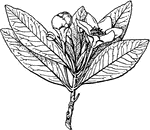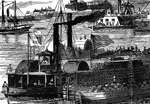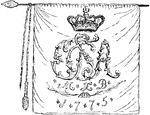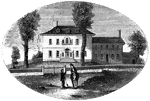
Morristown
Washington's head-quarters at Morristown. This view is from the forks of the road, directly in front…

Arnold's residence
Arnold's residence. Arnold lived in Water Street, near the ship-yard. The house is still standing (1848),…
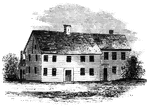
Buckley House
The Buckley House. This building stood upon the eastern side of the Green, fronting the church. It was…

Skirmish at Lexington
"Skirmish at Lexington. The largest building in the picture is the meeting-house, and the officer on…
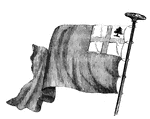
New England Flag
"The New England flag. This is copied from an old Dutch work, preserved in the library of the New York…

Lexington Monument
"Monument at Lexington. This view is from the Concord Road, looking eastward, and shows a portion of…
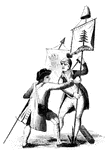
Pine-Tree Flag
"The Pine-Tree Flag. This engraving is a reduced copy of a vignette on a map of Boston, published in…

Gaspee Point
"Gaspee Point. This view is from the bank of the cove just below the Point, looking northeast, showing…

Society of the Cincinnati
"Society of the Cincinnati, member's certificate. This engraving is a fac simile of a certificate, about…

Order of the Cincinnati
"Order of the Cincinnati. This was drawn from an original in the possession of Edward Phalon, Esq.,…
Peekskill Landing
"View from Peekskill Landing. This view is from Peekskill landing, looking up the river. On the left…
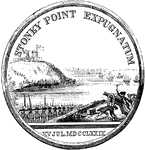
Wayne Medal Back
"Gold medal awarded by Congress to General Wayne. This is a representation of the medal, the size of…

White Shark
"Has the body elongated, swims with great ease, measures from fifteen to twenty feet, is extremely voracious,…
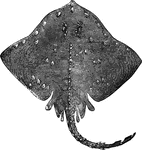
Thornback
"The prevailing color of the upper part, which is rough and with small points, is dark brown, the under…
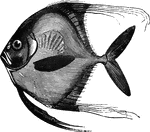
Blepharis
"Five to six inches long; blueish-white above, shiny beneath; found, though rarely, on the American…

Hawken's Gymnetrus
"Eight to ten feet long, depth ten inches, thickness less than inches; color dusky green; found in the…

Gilt-Head
"Six to eight inches long, its general color being red varied with green." — Goodrich, 1859

Common Cod
"It is two to four feet long, and weighs from two to seventy spounds; the general color is greenish…
Burbot
"Lives in slow-running rivers, is one to two feet long, conceals itself under stones like an eel, and…

Salmon
"The salmon two to four feet long, and weighs ten to twelve pounds, though it has been taken of eights…

Sleepy Hollow Church
"Ancient Dutch Church in Sleepy Hollow. This view is from the church-yard, looking southwest. The porch…
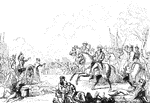
Monmouth
"The field of Monmouth. In the picture here given, the chief is seen most prominently on his white charger,…
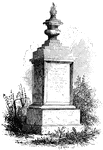
Woodhull's Monument
"Woodhull's Monument. This monument stands on the south side of the church. It is of white marble, about…

Common Carp
"It is ten to forty inches long, and sometimes attains the weight of a hundred pounds; the general color…
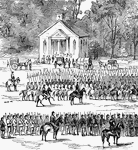
Battle at Willis Church
"Battle at Willis Church, Monday, June 30th, 1862- the Federal forces, under General Heintzelman, engaged…
Burning of the White House
"Burning of the White House- the Federal troops, by command of General McClellan, abandoning their position…
!["Siege of Petersburg- the Ninth Corps charging on the enemy's works after the explosion of the mine, July 30th, 1864. Immediately after the explosion of the mine a hundred cannons opened along the Federal front, and at half-past five the Ninth Corps charged, carrying the fort with a part of the line on each side. The Second Division, which was in the centre, advanced and carried the second line a short distance beyond the fort, and rested, holding ground with the utmost determination. It was at the time the [African American] Division, under General White, was pushed forward and ordered to charge and carry the crest of the hill, which would have decided the contest. The troops advanced in good order as far as the first line, where they received a galling fire, which checked them, and although quite a number kept on advancing, the greater number seemed to become utterly demoralized, part taking refuge in the fort, and the remainder running to the rear as fast as possible. They were rallied and again pushed forward, but without success, the greater part of the officers being killed or wounded."— Frank Leslie, 1896](https://etc.usf.edu/clipart/13900/13915/petersburg_1_13915_mth.gif)
Siege of Petersburg
"Siege of Petersburg- the Ninth Corps charging on the enemy's works after the explosion of the mine,…
!["Siege of Petersburg- the Ninth Corps charging on the enemy's works after the explosion of the mine, July 30th, 1864. Immediately after the explosion of the mine a hundred cannons opened along the Federal front, and at half-past five the Ninth Corps charged, carrying the fort with a part of the line on each side. The Second Division, which was in the centre, advanced and carried the second line a short distance beyond the fort, and rested, holding ground with the utmost determination. It was at the time the [African American] Division, under General White, was pushed forward and ordered to charge and carry the crest of the hill, which would have decided the contest. The troops advanced in good order as far as the first line, where they received a galling fire, which checked them, and although quite a number kept on advancing, the greater number seemed to become utterly demoralized, part taking refuge in the fort, and the remainder running to the rear as fast as possible. They were rallied and again pushed forward, but without success, the greater part of the officers being killed or wounded."— Frank Leslie, 1896](https://etc.usf.edu/clipart/13900/13917/petersburg_2_13917_mth.gif)
Siege of Petersburg
"Siege of Petersburg- the Ninth Corps charging on the enemy's works after the explosion of the mine,…

Old Church
"Desperate skirmish at Old Church, near Tunstall's Station, VA., between a squadron of the Fifth United…

Old Church
"Desperate skirmish at Old Church, near Tunstall's Station, VA., between a squadron of the Fifth United…

Battle of Munfordville
"Battle of Munfordville, Ky., Sunday, September 14th, 1862- the Confederates charging through the abatis…

Battle of Munfordville
"Battle of Munfordville, Ky., Sunday, September 14th, 1862- the Confederates charging through the abatis…
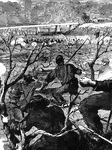
Battle of Munfordville
"Battle of Munfordville, Ky., Sunday, September 14th, 1862- the Confederates charging through the abatis…
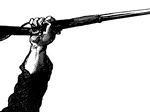
Hand with Gun
"Picture of a hand with a gun at the Battle of Munfordville, Ky., Sunday, September 14th, 1862- the…

Attack at Harrisonburg
"Gallant attack by 150 of the Pennsylvania Bucktails, led by Colonel Kane, upon a portion of General…
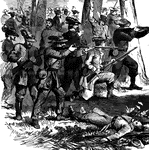
Attack at Harrisonburg
"Gallant attack by 150 of the Pennsylvania Bucktails, led by Colonel Kane, upon a portion of General…
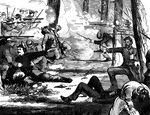
Attack at Harrisonburg
"Gallant attack by 150 of the Pennsylvania Bucktails, led by Colonel Kane, upon a portion of General…
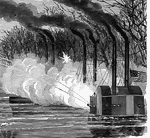
Bombardment of Fort Henry
"Bombardment of Fort Henry, Tennessee River, Tenn., by the Mississippi Flotilla, Flag Officer Foote,…

Bombardment of Fort Henry
"Bombardment of Fort Henry, Tennessee River, Tenn., by the Mississippi Flotilla, Flag Officer Foote,…
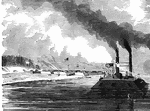
Bombardment of Fort Henry
"Bombardment of Fort Henry, Tennessee River, Tenn., by the Mississippi Flotilla, Flag Officer Foote,…
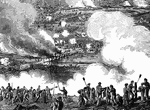
Battle of White Oak Swamp Bridge
"Battle of White Oak Swamp Bridge, Monday June 30th, 1862- Ayres's, Mott's and Randall's batteries checking…

Battle of White Oak Swamp Bridge
"Battle of White Oak Swamp Bridge, Monday June 30th, 1862- Ayres's, Mott's and Randall's batteries checking…
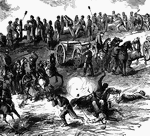
Battle of White Oak Swamp Bridge
"Battle of White Oak Swamp Bridge, Monday June 30th, 1862- Ayres's, Mott's and Randall's batteries checking…
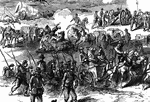
Battle of White Oak Swamp Bridge
"Battle of White Oak Swamp Bridge, Monday June 30th, 1862- Ayres's, Mott's and Randall's batteries checking…
!["The Pen-Fish or Common Calamary, <em>L. vulgaris</em>, is the best-known species of the genus; the body is somewhat pellucid, of a greenish hue, changeable to dirty brown; the eyes are large and lustrous, of an emerald green, phosphoric, and fiery in a high degree. It is common in the european seas, and was known to the ancient Greeks and Romans. [Shown with a quill pen]" — Goodrich, 1859](https://etc.usf.edu/clipart/14000/14004/cmncalamari_14004_mth.gif)
Common calamari
"The Pen-Fish or Common Calamary, L. vulgaris, is the best-known species of the genus; the…

Bishop's mitre shell
"Noted for a very long proboscis, sometimes twice the length of the shell. The latter is turretted,…

British Flag
"British flag. This is a representation of one of the flags surrendered at Yorktown, and presented to…

Wentle-trap
"The shell is mostly white and lustrous; turreted and many-whorled; the animal has a proboscis-like…

Bulla velum
"The B. velum is very elegant, and of a light-brown color; the apex and base are both white,…
!["View of the remains of the French Works. These remains are in the southeastern suburbs of the city, about half way between the [African American] Cemetary and the residence of Major William Bowen, seen toward the right of the picture. The banks have an average height, from the bottom of the ditch, of about five feet, and are dotted with pines and chincapins or dwarf chestnuts, the former draped with moss. The ground is an open common, and although it was mid-winter when I was there, it was covered with green grass, bespangled with myriads of little flowers of stellar form. This view is from the direction of the town looking southeast."—Lossing, 1851](https://etc.usf.edu/clipart/14100/14147/french-works_14147_mth.gif)
French Works
"View of the remains of the French Works. These remains are in the southeastern suburbs of the city,…

